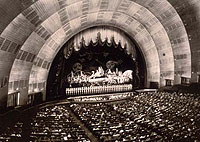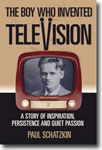

 |
The Farnsworth
Invention: Fact -v- Fiction
|
 |
Act II, Scene 4: In which the engine of drama begins to fly off the rails of history |
| The Play |
The Facts
|
|
| The scene begins with the opening of the Radio City Music Hall. Sarnoff is interrupted by a phone call. Good news: Zworykin has a picture, "using manageable light." | Remember, Zworykin visited Farnsworth while he was still in San Francisco in the spring of 1930, so we're kind jumping around in time here. After his visit to the Farnsworth lab, Zworykin dictated a 1200 word telegram to his colleagues back in Pittsburgh with complete specifications for an Image Dissector tube. By the time he reached Pittsburgh, the workers there had constructed a working model of an Image Dissector, which Zworykin later took with him to the new RCA lab in Camden, NJ. So, yeah, Zworykin had a picture alright. But he got it the same way Philo Farnsworth did. |
 The very Art Deco Radio City Music Hall -- home of the Rockettes -- opened on December 27, 1932 |
| Sarnoff says "it's the clearest picture that has ever been transmitted." | Again we come back to this business about Farnsworth's "light problem"
-- like it was some kind of fatal flaw that negated everything else his
invention accomplished.
Starting in late 1932 or or early 1933, Vladimir Zworykin began conducting successful experiments with an electronic television system based on a new camera tube, which was dubbed the Iconoscope. The Iconoscope did offer some notable improvement in signal strength and sensitivity, but it also employed a triangular geometry that had its own inherent shortcomings. The play's implication that these early Iconoscopes solved Farnsworth's "light problem" overstates the case by at least a full order of magnitude. Furthermore, the Iconoscope's primary innovation, the "storage principle," was actually discovered by somebody else altogether: An Hungarian researcher named Kalman Tihanyi. It is still more important to note that the Iconoscope was a striking departure from Zworykin's 1923 patent application. However, that would not stop RCA from insisting that Zworykin's 1932 tube and his 1923 patent application were one and the same. That contention would ultimately be resolved by the patent courts -- a couple of times. |
|
| As they are leaving Radio City Music Hall, Sarnoff gets into an argument with his wife about what's going on with Zworykin in Camden. She asks "how is it that for ten years, Vladimir can't get a picture..." but within a month of visiting San Francisco he's got "the clearest picture..." | While we were not privy to all of David Sarnoff's private conversations with his wife, we'll go out on a limb here and say this one is fiction. It seems oddly incongruous, if not ironic, that the essence of this drama has been distilled into a confrontation between Sarnoff and his wife. |
|
| Lizette asks "what is the 'get around Farnsworth' department?" | That was the unofficial name of Zworykin's unit at the RCA Camden lab, and the Iconoscope was the result of RCA's determination to "get around" Farnsworth's patents. But there were just as many technicians at the RCA lab who were eager to "get around" the Iconoscope, and Farnsworth would ultimately provide them with the means to do just that. | |
| The scene ends with Lizette leveling an accusation at her husband: "I think you just stole television!" | Maybe that's the point to this whole exercise: that Sarnoff TRIED to "steal" television from Philo Farnsworth but FAILED in the attempt, as we'll find out in Act II scene 6, RCA ultimately wound up paying another company for the use of new technology to further its corporate aspirations -- for the first time in its history. But you won't hear anything about that in this play. It's so much easier just to say "Sarnoff stole television and that's why you've never heard of Philo Farnsworth. The real story is not that simple, but if a writer of Aaron Sorkin's caliber can't get it right, then maybe nobody can. | |
Want the whole story? Read a Book! |
 The Boy Who Invented Television A Story of Inspiration, Persistence, and Quiet Passion by Paul Schatzkin |
|